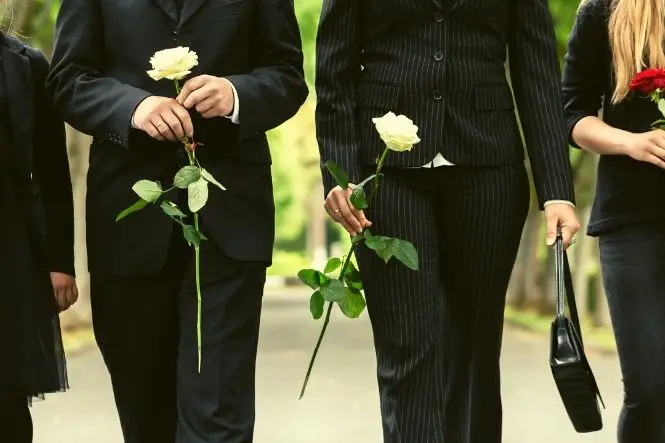The modern image of the funeral is one where everyone is dressed in black, formal clothing. It’s considered rude or even disrespectful to show up in any other color, especially something bright. But why is that? Why do people wear black to funerals?
Black, as a mourning color, dates back to the Roman Empire, where royalty and other elites would wear black or dark purple togas and robes. It was made a more commercial mourning color in the 1800s by Queen Victoria, and has become the standard in Western Christian culture.
Here’s what you need to know about black as a funerary color.
Black Clothing and the Renaissance
Every culture has had its own traditions and rules when it comes to death and honoring the dead. These rules applied to how the body was handled, what foods were eaten, and even how long the family was required to stay in mourning.
In almost all of these traditions, the colors worn by the family and loved ones of the deceased represented their mourning to the community, and their celebration of the deceased.
These colors have changed throughout time, but have shared some commonalities since roughly the Roman Empire. In that time, darker togas and robes were customary for the family to wear in their period of mourning. This tradition carried into the Middle Ages, where mourning clothes were described as “somber.”
Though these clothes almost always had a very particular style and decorative scheme associated with them, the exact colors weren’t specified in many cases. They could be practically any dark color, with royalty and particularly religious mourners in the Christian tradition choosing darker shades of purple.
The Limited Availability of Dark Dye
The problem was that dark colors like black and purple were extremely expensive to attain, as the dyes were made using rare plants and other pigment sources. Only the very wealthy – primarily royalty – could wear a truly black or deeply purple garment, so mourning colors were usually whatever relatively somber piece was in the mourner’s possession.
As technology evolved and made darker dyes available for the general public, dark greys, purples, and blacks became the standards for not only professional or formal attire, but also clothing associated with morning for the higher classes and the more elite end of society beyond royalty.
In the later Middle Ages, black was used to distinguish members of a funerary procession from the watching crowd; all members wore it, though they were separated by class and hierarchy as they proceeded. The higher up you were in the ranking system, the more elaborate your clothing was and the more likely it was to include long trains and hoods.
Still, this level of mourning was reserved for the higher classes until black dyes became widely available during and after the Industrial Revolution.
Queen Victoria and Mourning
The modern funeral traditions we know in the Western world took shape with Queen Victoria of England in the 1800s, whose mourning of her husband Prince Albert lasted 40 years. Though black had been a mourning color since the Romans, it became the Western standard with her elaborate mourning rituals.
The Queen wore exclusively black gowns and accessories, including veils, for the entire time, and popularized black as the color of British mourning. There was also a swath of funerary jewelry including jet rings and brooches with clippings of the deceased’s hair.
Victorian widows were instructed to wear only black for a year or more, and were even unable to expose their faces for the first six months after their husband’s death. Widowers of the time had slightly less strict rules, only having to mourn for three to six months, but frequently wore black or very dark suits for years afterward.
This tradition carried, as many do, to other European cultures and, eventually, to the United States as more and more popular figures took up black as their mourning standard. An entire industry of funeral attire and accessorizing sprung up, and it has only increased in size over time.
Today, though we don’t have formal periods of mourning for everyday people, most Western funeral goers, especially those in Christian faiths, are still expected to wear black or other very dark colors.
Alternative Mourning Colors
Black isn’t the only mourning color, of course. Here are some of the colors chosen by cultures around the world.
- Cambodian, Chinese, and indigenous Australian mourners often wear white as a symbol of rebirth and purity, in the symbolic hope that their loved one is born again or moves on to a positive afterlife.
- Guatemalan Catholics will wear purple during Holy Week to represent their mourning for Christ’s suffering on the cross. In Thailand, purple is specifically reserved for the spouse of the deceased, while other mourners wear black.
- Mourners in Papua New Guinea will often wear jewelry and body paint made of stone grey clay. Widows will dawn many long, beaded necklaces and remove one each day following their spouse’s death. The mourning period lasts until the last of the many beaded necklaces worn is removed.
Conclusion
No matter what your color preference, funerary attire is designed to honor the dead. Whether this means a black suit or brightly colored party clothes, it’s a sign that you are wishing the best for your departed loved one, and that you are honoring their life and what they wanted.
For your own funeral, you might request mourners wear a different color. Maybe you want it to be a more lighthearted celebration, or a simpler, less formal event. Whatever you choose, specifying can make it easier for your loved ones to reconcile with the event.
If you want to go back to basics, though, black is a good, simple, formal color for funerals.


